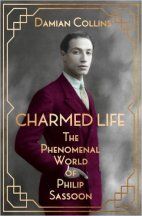Charmed Life: The Phenomenal World of Philip Sassoon - Damian Collins

Charmed Life: The Phenomenal World of Philip Sassoon - Damian Collins
Non-Fiction
Pages: 400
If ever a man lived the 'Downton Abbey' ideal life of the rich and glamorous, that man was Philip Sassoon, a man with beautiful houses and luxury estates, private planes, paintings and antiques, with all the world his for the asking price. He was also something of an outsider - permanently single, potentially gay, with an Oriental exoticism from his Middle Eastern Jewish roots - who simultaneously cultivated the most elevated of social circles, operating at the very heart of the social and political elite. He was friends with royalties and celebrities, Prime Ministers and diplomats, artists and athletes, his various homes the centre of a vibrant and colourful social set that has come to epitomise the decadence and glamour of the interwar years.
But it wasn't all luxury and aesthetics. Sassoon served as MP for Hythe for almost his entire adult life, inheriting the seat from his father in his youth. Sassoon fought in the First World War, albeit not in the trenches but as Douglas Haig's right-hand man, a position he also filled with David Lloyd George in the immediate post-war years. He was Minister for Air and whilst serving his government loyally also supported Churchill in his opposite campaign to increase military spending, agreeing with Churchill's wilderness position of warning against the growing Nazi threat.
All things considered Sassoon was a man of mystery and romance, around whom swirled many of the pivotal figures of the time, all of which makes for a fascinating read. His life serves as a real prism in which to view the decade and wealth of the era. And yet there is almost a Sassoon-shaped hole at the centre of this book, because the man himself remains beyond reach. His life is well documented but there is little of the personal, the private, the intimate here. His loves and desires, his impulses, his motivations, his hopes, his regrets - all remain opaque. I'm not even entirely sure I can call this book a biography - one usually leaves a biography with more of a sense of the personal than is present here. In some ways this is almost more about the events and the people in which Sassoon was so intimately connected than it is about him. And yet at the same time, for a man so keen to cultivate important people and be of use to them, that seems strangely appropriate as well.